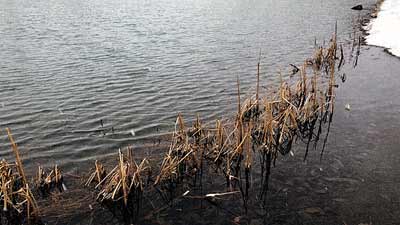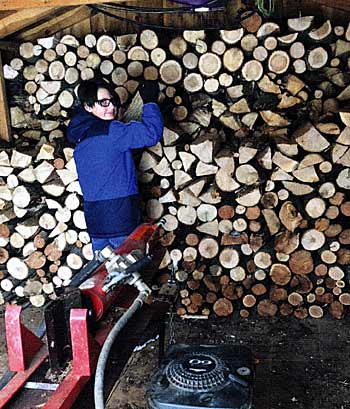
As we sit here in upstate New York, the has changed around us. We are locked down in a new state called Covid-19. Our son is home from school but not off from school. His lessons are delivered in packets from school, coupled with online sessions from his teacher. He has a Zoom meeting with his music teacher tomorrow, learning to play the saxophone and wanting approval for several new songs and skills. The college where I teach prides itself in firsthand, experiential learning through doing. This entire hands on college is being brought 100% online. Unprecedented. My parents and in-laws are in lockdown, communicating with family through FaceTime. We are dropping groceries at their door. My son has a FaceTime chat group, rather than a playgroup. Has life changed? Yes, a little, but I really am not complaining.
The same is probably happening to you and yours, too.
Outside time plays a familiar role now, though now our property and pond are of increased importance. Now, it's not just aesthetics, it's also our park, playtime, exploration area, escape, and educational classroom. We are fortunate to live in an extremely rural part of New York, with acres of open land, dirt roads, ponds, and lakes. The hardships of living in the country have paid off in the advantages, space, and social distance that we can enjoy.
Now, as I walk around the property, I see firewood to be cut, our free-range chickens pecking away in self-sufficiency, and deer in the fields eating the first succulent spring greens, as their now-shabby, warm winter coats are sloughing and falling out. The first of the wild ramps (leeks) are poking through leaf litter by the stream. Geese are pairing up and creating a ruckus in the wetland nearby, and they can be heard for miles. Small Pumpkinseed sunfish are gathering in the shallows of the pond, feeding on small crustaceans. A few small Bullhead catfish join them. We have no idea how they got there. It's one of those mysteries of nature. The last of the ice on the pond is finally gone for good this spring and the water is crystal clear. Today, we had another final shower of snow before totally yielding to spring. Skeletons of last year's cattails are standing, adding a bit of early structure to the shoreline.

I am struck by the diversity I see in my pond and surrounding landscape. Forest, trees, wetlands, emergent plants, submergent plants, deep water, shallow water, and several types of substrate. I am reminded of the words of Aldo Leopold (and I am paraphrasing here), "A diverse ecosystem is a stable ecosystem." A diverse system is resilient and can recover from change. A diverse system does not rely on just one mode of production, one mode of delivery, or a single food item. A complex ecosystem has many threads, and if one breaks, others catch the weight until the broken thread repairs or is replaced. The ecosystem is similar to really good, living rope. When one thread frays, others can bear the weight. Diversity spreads risk, is stronger, and is more likely to recover from a mistake or a catastrophic change.
A monoculture is a plant community (usually crops) that is not diverse and is dominated by one species. Monocultures, in turn, support a lower diversity of invertebrates and fish. Plants are at the base of every food chain, your pond included. Diverse plants start with diverse physical habitats and substrates in varying depths. Plants grow best in shallow water in stable sediments that are not exposed to wave action. Organic material accumulates, light penetrates to the bottom, and voila! Plants. Habitat diversity is created in the shallow water of a pond by having some mega rocks, some large rocks, small rocks, and some gravel. Attached algae and periphyton grow on those rocks and feed insects that scrape algae for their food. Calm, shallow, sheltered water allows organic material to deposit, creating stable, softer sediments that provide habitat for burrowing insects and rooted plants. Submerged plants will grow here. These submerged macrophytes should be diverse, dominated by native plants.
Depending on your zone of the country, floating-leaf pondweed, variable-leaf pondweed, big-leaf pondweed, American pondweed, elodea, coontail, and other natives are good, especially in a mixed, diversified community. Cattails, pond lilies, arrowhead, and a variety of sedges, rushes, and grasses are good nearshore emergent habitat. This is good cover for really small fish to avoid predation. How much of the pond bottom should be covered with plants? All of the bottom in clear water less than six feet deep will likely be covered with submergent plants. Chara (stonewort) may grow deeper in clear lakes. Less than 50% of this coverage area should be natural plants with floating leaves because they produce a strong canopy, reducing light and surface interactions. I have visited several lakes where water chestnut covers 100% of the surface and dissolved oxygen was zero in the summer. One of those lakes was devoid of fish and nearly dead. Try to keep milfoil, water chestnut, and phragmites out as they will produce a monoculture by essentially outcompeting and eliminating other preferred, native plants.
Shallow ponds (less than six feet) are more biologically productive because all of the water column is in the zone of sunlight penetration. However, they lack the diversity of deep, open water to get them through the winter or summer. In the North, some deeper water is very important because it provides a large volume of water for oxygen storage in winter months that will keep the pond from winterkill. Also, aesthetically, I like a deep pond for swimming. Our home pond is ringed with shallow, productive water less than seven feet where most of the plants and fish are produced. I put in a dock to get past all those plants (and leeches) and into deep water for swimming. Incidentally, that is where my large golden shiners school, away from the bass and where plankton are plentiful.
The bait production ponds at the college where I work are the opposite example of aquatic diversity. These shallow ponds are purposely four to six feet deep and green with planktonic algae in summer. They produce a crop of zooplankton, which in turn produces a crop of only fathead minnows. The production ponds are very green, not pretty, and built to do one thing, produce the maximum amount of fathead minnows. Period.
When should you think of this diversity in habitat? All the time. The easiest is to start when you build the pond. You may want to incorporate scalloped edges, varying depths, diverse bottom types with multiple types of rocks of many sizes. And then remember everything less than six to seven feet deep will likely have plants carpeting the bottom. In water less than three feet, emergent plants will dominate.
Diversity of habitat, and diversity of plants, gives the pond a host of invertebrates and the fish that eat them. A healthy, stable ecosystem that is resilient to change follows. As I walk the shores of my pond with my family, this stability gives us strength, resilience and comfort as we move forward through these uncharted waters.
Reprinted with permission from Pond Boss Magazine



